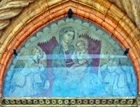

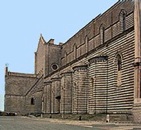
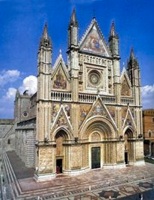
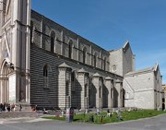
North wall South wall
The cathedral walls were built using alternating bands of basalt (black) and travertine (white): whole blocks were used on the lower part, with faced blocks above. The fine façade masks the inner structure, which can however, be seen from the sides. The following elements were completed in the period 1290 - 1310:
-
✴the high nave and clerestory above;
-
✴the lower narrow side aisles, each of which is pierced by five side chapels; and
-
✴the transepts, which protrude as far as the walls of the aisles.
The plan was subsequently augmented:
-
✴Buttresses were built in ca. 1310 to take some of the weight of the transept vaults.
-
✴The original apse was replaced by the present rectangular tribune in 1328.
-
✴The Cappella del Corporale was built between the buttresses of the left transept in 1350-6.
-
✴The Cappella Nuova was built between the buttresses of the right transept in 1406-25, after the demolition of the old sacristy and a side chapel there.
Side Doors
There are three side doors to the Duomo (discussed under separate headings below):
-
✴Porta di Postierla (or Porta Soliana) is on the south wall, just before the wall of the Cappella Nuova.
-
✴There are two entrances in the north wall:
-
•the Porta del Corporale, just before the wall of the Cappella del Corporale; and
-
•the Porta di Canonici, between the third and fourth side chapels.
Porta di Postierla (ca. 1310)
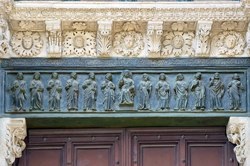
The sculpture of this magnificent portal seems to belong to the last phase of construction of the Duomo (ca. 1310), and in particular is close to the sculpture of the capitals of the two pairs of columns in the nave that are closest to the facade.
-
✴Its design and sculpted elements are attributed to Ramo di Paganello, who seems to have been capomaestro of the Duomo in ca. 1302-10.
-
✴The bronze architrave, which depicts Christ and the Apostles, is inscribed:
“Rubeu[s] fec[it] h[oc] op[us]”
Rubeus made this work
The lunette of this portal was originally split into three fields by two twisted columns. These were removed in 1890 because it was thought that they had originally belonged to the monument of Cardinal Guillaume de Bray in San Domenico.
Porta del Corporale
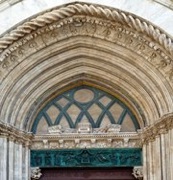
According to tradition, this was the entrance through which the Sacra Corporale first entered Santa Maria Prisca in 1264. This entrance was closed in the 16th century and re-opened in 1891.
-
✴An original fresco in the lunette, which depicted the Miracle of Bolsena was restored in 1362 and furnished with an explanatory inscription. No trace of it survives.
-
✴The bronze architrave (1889), which depicts [the Assumption of the Virgin], was cast to a design by Adolfo Cozza and was inspired by the architrave of Porta di Postierla.
Christ and Angels (1347-8)
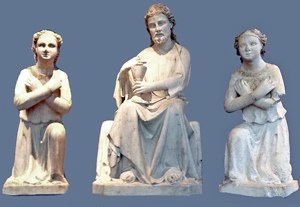
These figures came from an altar in the left of the nave of the Duomo that might have housed the Sacro Corporale while the Cappella del Corporale was in construction. They were moved from the Duomo to the plinths in the exterior lunette of the Porta del Corporale in 1890, and the angels were subsequently badly damaged. They were removed from this location in 1985 and are now in the Museo dell' Opera del Duomo.
-
✴The figure of Christ is attributed to Nino Pisano. He is seated and holds a chalice in His right hand: the wafer that was originally in His left hand has been lost.
-
✴The two angels (both of which have been damaged) were probably those that were made from the marble that Andrea Pisano (see above) sent to the Duomo in ca. 1347. They are of inferior quality and are attributed to Tommaso Pisano.
Porta di Canonica
